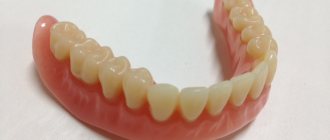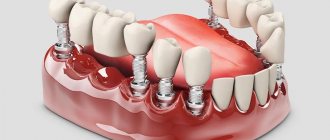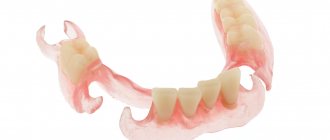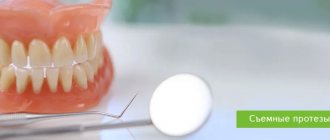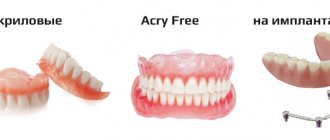The problem of recreating lost teeth arises not only due to age-related changes in the human body. Often young people also lose teeth: this can be caused by injuries, hereditary predisposition, or the environmental conditions of the person’s place of residence. If one tooth is lost or partially destroyed, the client of the dental clinic has many options for restoring it (veneers, crowns, inlays, implants, etc.).
The situation is more complicated when a person needs dental prosthetics in the absence of a large number of teeth: in this situation, based on the individual picture, the dentist often offers only one of the ways to recreate the dentition.
Modern dentistry has many different materials and methods of prosthetics in different situations, each of them has its own advantages and disadvantages, differs from others in the complexity of installation and cost. If you have lost several adjacent teeth or have no molars at all, we will tell you how to get dentures and what to pay attention to. The dentists at the Meliora Dent clinic will help you find the right option based on your specific situation and in accordance with the client’s requirements and capabilities.
| Prices and methods of dental prosthetics in the absence of more teeth | |
| Metal-ceramic crown | from 15000 R |
| Metal-free crown | from 25000 R |
| Zirconium crown | from 25000 R |
| Plastic prosthesis | from 22500 R |
| Nylon prosthesis | from 22500 R |
| Clasp prosthesis | from 22500 R |
| Dental implantation | from 25000 R |
Methods of dental prosthetics in case of large absence of teeth
Before proceeding with methods of prosthetics in the absence of a large number of teeth, it is necessary to define the concept of prosthetics itself and the features of each of its types. After all, it is precisely these features that determine the possibility of recreating the dentition in the event of the loss of several adjacent teeth at once.
Dental prosthetics refers to the professional reconstruction of the lost form or function of both missing and significantly damaged teeth. Therefore, prosthetics include restoration methods such as inlays, veneers and crowns, which are inappropriate to describe in relation to the situation under consideration (they are applicable for restoring destroyed or damaged teeth).
Here are the main groups of prosthetic methods, each of them includes those that are applicable when prosthetics are needed in the absence of one , two or more teeth:
- Fixed prosthetics is a method of installing a long-term structure in the patient’s mouth. Used to recreate one or two adjacent teeth (lost or damaged). Fixed prosthetics has the following features:
- the device cannot be removed without breaking it;
- the prosthesis is not able to evenly distribute the load on the gums; all the pressure falls on the teeth to which the device is attached;
- For permanent prosthetics, the following materials are used: metal alloy;
- ceramics;
- do not require filing and depulpation of nearby supporting teeth;
- according to the size of the prosthesis;
By mounting method:
- By redistributing the chewing load.
- Implantation is the insertion of a pin into the jawbone on which an artificial tooth is installed. Based on implantation, both fixed prosthetics are performed (artificial crowns are installed on the implant) and conditionally removable (a removable structure is attached to the implants). The second method is optimal in a situation of complete loss of teeth.
Next, we will describe all possible methods of dental prosthetics in the absence of them, indicating the advantages and disadvantages of each.
How to replace teeth with missing molars: bridge
A bridge is the only applicable method of permanent prosthetics in the absence of several adjacent teeth. It consists of connected crowns, the outer ones are put on healthy teeth (close to those that are missing).
The need to grind down the supporting teeth is the main disadvantage of this type of prosthetics, which often forces patients to look for other methods. Today bridges are secured in alternative ways:
- on metal plates;
- using a special adhesive.
Crowns for bridge structures are made from the following materials;
- ceramics;
- metal ceramics;
- plastic.
For the most part, the price of the issue depends on the material from which the prosthesis is made, as well as whether it is necessary to restore one tooth or whether prosthetic teeth are needed in the absence of a large number of them. The cost of one crown in our clinic is from 15,000 rubles. for metal ceramics up to 25,000 rubles. and more for ceramics.
Plastic crowns are installed as temporary crowns. Installing crowns made of plastic on chewing teeth is not advisable - this material is not sufficiently stable, and the crown can easily break.
The service life of a prosthesis depends on the number of missing teeth it replaces: the more crowns it has, the less it will last. On average, you should expect 5-7 years of using a bridge.
Over time, bridge structures become mobile, which can lead to unpleasant consequences:
- bleeding gums;
- exposure of the neck of the supporting tooth;
- food residues getting under the structure.
How to replace implants on front teeth
The frontal elements are not involved in chewing food, but high aesthetic demands are placed on them. As an alternative to implantation, a dental bridge is suitable for restoring teeth in the front row.
Metal-ceramic structures are not used in the smile area: the metal base darkens in the light; upon contact with metal, the mucous membrane may darken. Solid ceramics is a durable material, characterized by natural translucency, and looks like “your own” tooth. The most accurate, aesthetic and durable option is a zirconium dioxide prosthesis.
Methods of dental prosthetics in case of large absence of teeth: removable structures
Removable dentures are the main option for recreating a row in the absence of a large number of teeth (more than two in a row). A removable denture consists of several parts:
- The denture base is the basis of the structure, which is located on the gum tissue (can be attached by suction or gluing with medical gel), to which artificial teeth are attached. The base is made from different materials, which determines the cost of the prosthesis, its comfort and other features;
- Artificial teeth made from plastic or porcelain;
- Devices for fixing the prosthesis in the mouth (clasps and micro-locks).
According to their design, depending on the number of teeth being replaced, removable dentures are divided into:
- complete - with complete edentia;
- partial – when part of the dentition is replaced.
When choosing the type of removable denture, pay attention to the material from which it is made. Let's consider the main types of removable structures distinguished by this criterion:
- acrylic;
- nylon;
- clasp
How to make dentures: acrylic denture
Acrylic (plastic) prosthesis is the cheapest prosthetic option. A complete acrylic denture (replacing the entire jaw) is attached by suction, a partial denture is attached to the supporting teeth using a clasp. Using a small acrylic prosthesis (butterfly), you can replace even a single missing chewing tooth (at the patient’s request, if he refuses to grind down the supporting teeth for crowns).
Complete removable acrylic denture.
The advantages of an acrylic prosthesis are:
- Relatively low cost (full or partial dentures in the absence of a large number of teeth - from 10 to 20 thousand, for one or two teeth - 3-4 thousand);
- Lightness of the prosthesis;
- Load distribution when chewing;
- An acrylic prosthesis is made quickly and easily, and is easy for the patient to care for.
Disadvantages of acrylic prosthesis:
- Injury to soft tissues (especially at the beginning of use);
- Possibility of allergic reactions;
- Discomfort when wearing a complete denture due to the overlap of the palate;
- High degree of odor absorption;
- Possibility of damaging abutment teeth with fasteners;
- Impaired diction, possible voluntary collapse of the prosthesis.
Prosthetics in the absence of teeth: nylon prosthesis
The base of a nylon removable denture, unlike an acrylic one, is made of a soft elastic material, which eliminates the design from many of the disadvantages of the latter: rubbing, absorption of odors, etc. Reviews about dental prosthetics in the absence of a large number of teeth using a nylon denture are ambiguous:
- The prosthesis is quite expensive (from 20 thousand rubles) and has a short service life - 2-3 years;
- Eating is uncomfortable due to the heavy load on the gums in places where teeth are missing;
- With prolonged use of a denture, difficulties arise with high-quality cleaning of teeth.
Prosthetic restoration of a missing tooth: clasp design
Byugel represents a design with a metal arc base. The convenience of clasp prosthetics lies in the small volume of the structure and the variety of fastenings (clasps, attachments, telescopic crowns can be used). Bugel has the following advantages:
- correct distribution of chewing load;
- long service life - up to 7 years;
- This design can be installed for bruxism and periodontal disease.
The main and only drawback of the clasp is its high cost - from 50 to 100 thousand rubles.
Complete removable clasp denture.
Cost in Moscow and other cities
The price of a chewing tooth prosthesis depends on the amount of work and type of prosthetics. For example, if the root is intact, you need to install a stump tab and 1 crown - here the average cost of prosthetics will be 15 thousand rubles. If you need a bridge, then the cost of prosthetics is at least 25 thousand. A removable “butterfly” costs about 7,000 rubles, and the price of a clasp or “Quadrotti” will be at least 45 thousand. An inexpensive crown with an economy-class implant together cost about 30-35 thousand, and premium ones – from 80 thousand rubles.
1Naumovich S.A. Orthopedic dentistry. Prosthetics with removable plate and clasp dentures, 2009.
Author: Nepochatykh V.V. (Thank you for your help in writing the article and the information provided)
Implantation
Implantation is the most modern method of restoring dentition, which is the implantation of a rod into the bone tissue, onto which a removable or fixed structure is attached. With all the advantages (reliable fixation, restoration of dentition of any length, aesthetics, long service life), implantation also has disadvantages:
- high price;
- high level of trauma and pain;
- likelihood of rejection;
- the likelihood of complications from the nervous system;
- a large list of contraindications.
You can find even more about the features of restoring lost teeth through removable and fixed prosthetics, and how much it costs to install an implant in the materials on our website.
The Meliora Dent clinic offers a full range of dental services, including all types of prosthetics and implantation.
What can lead to tooth loss
Tooth loss begins with periodontal disease.
The first cause of adentia is periodontitis.
The second reason for tooth loss is caries.
The next cause of tooth loss is pulpitis
Other causes of tooth loss include periodontitis and hypoplasia.
Another reason for the development of edentia is diabetes mellitus.
If tooth extraction was previously carried out in a patient with diabetes, then it is necessary to understand that diabetes in general accelerates the atrophy of tissues, bones, and all degenerative processes in the body: from vascular sclerosis to trophism of the limbs. And in this case, it also affects edentia.
Look at the example of one of the patients with insulin-dependent diabetes mellitus, how he developed atrophy. Of course, this does not happen instantly, over several years, but edentia is an inevitable fact, unfortunately:
The professional experience of the specialists of the German Implantology Center allows us to successfully solve even such, sometimes very complex problems associated with atrophy and edentia by performing bone grafting and sinus lifting with subsequent implantation:
This clinical case and its successful treatment are reviewed in more detail - HERE
That is, there are two main reasons for tooth loss:
The first is periodontal disease (periodontitis), the second is caries and its complications (pulpitis and periodontitis), hypoplasia.
There are other reasons, but they are, let’s say, quite exotic and “don’t make a difference.” At the moment, there is no consensus on why caries and periodontitis occur and how to prevent them.
There are many theories, but there is no single answer to the question of how to prevent the development of these diseases. In my opinion, this suggests that these are multifactorial processes that involve genetics, nutrition, hygiene, the nature of the area in which a person lives, and so on and so forth... Why am I saying this? And to the fact that the reasons for development are a separate topic for discussion and we will return to it later, but now let’s look at the consequences of tooth loss.

